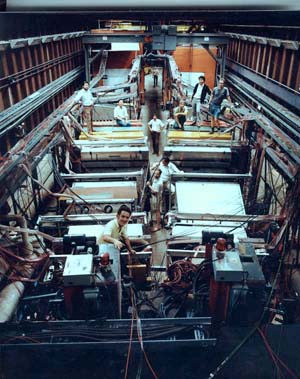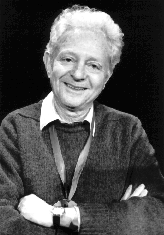 |
Run II Discovery |

|
The Discovery of the Bottom Quark
Leon Lederman, Fermilab and the Nobel Prize 1977
What is Fermilab? - Run II Newscasts - Analyze the Data - Particle Physics Bibliography
News Flash 1977: The Bottom Quark is Discovered at Fermilab
The Upsilon Detector used to discover the bottom quark
Batavia, IL It is 1977. The Standard Model is not yet fully formed. The existence of protons and neutrons can be explained with a simple two-quark model consisting of the up quark and the down quark. (The proton is made of two up quarks and one down quark, while the neutron is made of one up quark and two downs.) More evidence has come in, though, of particles, called mesons, that were made up of quark-antiquark pairs, including two new quarks: the charm and the strange. The charm has recently been discovered as a constituent of the J/psi meson. Leon Lederman of Columbia University leads a team at Fermilab on a detector designed to find a new meson: the upsilon. The upsilon is found at Fermilab to have the astounding mass of 9.5 GeV—that is 10 times the mass of the proton.
The way the upsilon was discovered is interesting. This meson has a very short lifetime and is therefore hard to detect. So what Dr. Lederman and his colleagues did was to fire a beam of protons at a target. Various kinds of mesons were produced and decayed. The upsilon, in fact, decayed into a pair of muons. These muons could be detected and tracked. Use of the tracking information told the energies and momenta of the muons—which could then be traced back to find the new upsilon particle and its mass.
Analysis of the properties of the upsilon has confirmed that it is made from the quark-anitquark pair of a new kind of quark. This quark has been called "beauty" or "b" but is now commonly referred to as the bottom quark. Note that at 4.3 GeV, a single bottom is 4.5 times the mass of a proton. The bottom is the first of a new third generation of quarks. As each generation has two types of quark, the discovery of the bottom initiates the search for its partner.
Leon Lederman
Discovery of the Bottom Quark - Historic Pictures and Documents - Leon Lederman's Biography

